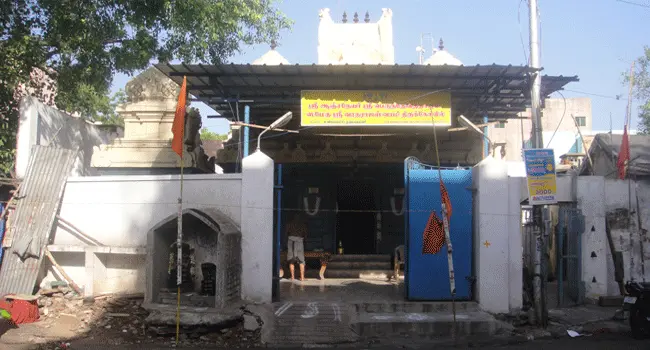
The protective wall for Madras
British were trying to strengthen their hold on Madras and they were facing threats from the French and the Mysore Sultanate. Hence they thought of fortifying the entire Madras town by building walls on all three sides with the fourth side already protected by sea. Before the wall was built, Tippu Sultan raided the city in 1767 and Haider Ali in 1769. Water supply from the Seven Wells, the Government House, and the St. Thomas Mount had come under threat then. These raids hastened the English to take up the project of building the wall for the town immediately.
They had built the northern wall with four entry points, Boatmen Gate, Pully Gate, Tiruvatore Gate, and Ennore Gate, and completed the northern wall by the end of 1769. In today’s scenario this wall would have run along the present ‘Basin Bridge Road + Old Jail Road +Ebrahim Sahib Street’.
Old Jail of Madras
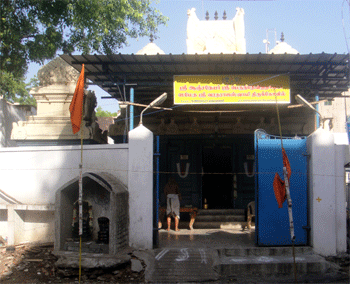 Madras was then under the British. A prison named ‘civil debtors prison’ was established by the rulers to imprison money defaulters. A strange practice was adopted by the British then to meet the expenditure of inmates of the prison. The complaints should bear the expenditure of the respective inmate in the prison. The prison thus established by the British was adjacent to the protective wall built north of the Madras.
Madras was then under the British. A prison named ‘civil debtors prison’ was established by the rulers to imprison money defaulters. A strange practice was adopted by the British then to meet the expenditure of inmates of the prison. The complaints should bear the expenditure of the respective inmate in the prison. The prison thus established by the British was adjacent to the protective wall built north of the Madras.
Today the stretch between Mint Clock Tower to Bharati Women's College is called Old Jail Road. The civil debtors’ prison was located in the present-day complex of Bharati Women’s College. The prison was moved near General Hospital and then to Puzhal. The old jail was housing Central Polytechnic which moved to Adyar. It was the country’s first printing technology institute.
Broadway
Broadway today known as Prakasam Salai runs north-south connecting China Bazaar Road in the south with Ibrahim Sahib Street (Old Jail Road) in the north. At the northern end of Broadway was the Tiruvatore Gate of the old town wall. The area was owned by Stephen Popham, a former British MP and later the advocate general in Calcutta, who moved to Madras in 1778. The road was first known as Popham Broadway. The road divided George Town into Muthialpet and Peddanaickenpet. With the new settlement of communities new temples were also built.
Sri Anjaneya Temple in Broadway
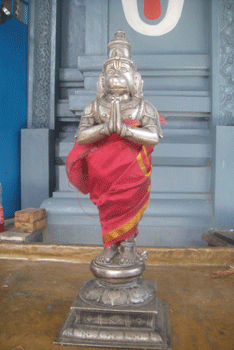 Madras [George Town] was then dominated by persons who influenced the British and acted as ‘go-between’ locals and the British. These people who had sway in governance are known as dubhashi i.e. people who know two languages [du+bhasha]. Many of Muthialpet and Peddanaikenpet were owned and developed by these people. The locality and street bear the name of these men. They had built many temples in these localities. One such was a temple for Sri Anjaneya right on Broadway itself. It is located opposite the now-defunct Broadway talkies. The temple was revived around one hundred and fifty years ago. Therefore it could be stated that the temple is much older than that. The design, structure, and posture of the Lord embossed as the ardha-shila also confirms that the temple should be much older.
Madras [George Town] was then dominated by persons who influenced the British and acted as ‘go-between’ locals and the British. These people who had sway in governance are known as dubhashi i.e. people who know two languages [du+bhasha]. Many of Muthialpet and Peddanaikenpet were owned and developed by these people. The locality and street bear the name of these men. They had built many temples in these localities. One such was a temple for Sri Anjaneya right on Broadway itself. It is located opposite the now-defunct Broadway talkies. The temple was revived around one hundred and fifty years ago. Therefore it could be stated that the temple is much older than that. The design, structure, and posture of the Lord embossed as the ardha-shila also confirms that the temple should be much older.
Temple today
The signboard of the temple declares it as ‘Sri Anjaneya, Perunthevi sametha Sri Varadharaja Swamy Thirukovil’. Sri Varadharajar, Perunthevi Thayar, Andal, Anjaneyar, and Nadadoor Ammal are the deities that are worshipped here. The temple is now managed by followers and the dynasty of Sri Nadadoor Ammal. ‘Nadathur Ammal Varadhaguru Trust’ is maintaining a website on this temple. The legend of this temple would be incomplete without a biography of Sri Nadadoor Ammal.
The temple was revived around one hundred and fifty years ago. Therefore it could be stated that the temple is much older than that. The design, structure, and posture of the Lord embossed as the ardha-shila also confirm that the temple should be much older.
Brief biography of Nadadoor Ammal
Sri Varadaguru
Sri Varadaguru later came to be known as Nadadoor Ammal, was the son of Devaraja Mahadesikan. After initial studies under his father, he was sent to Engal Azhvan by his father for further studies. Sri Varadaguru had his full training and learned Vedanta from his Guru Sri Engal Azhvan. After his Guru Sri Engal Azhvan attained Acharya tiruvadi at Kollagonda, near Srivilliputtur he fulfilled his duties as a true disciple. He returned to Kanchi where he continued Sri Bhashya Upanyasa. His sweet rendering and excellent discourse attracted many disciples like Appullar alias Atreya Ramanuja, Vadakku Thiruveethipillai, and Sudarsanasuri, the great-grandson of Koorathazhvan.
Nadadoor Ammal
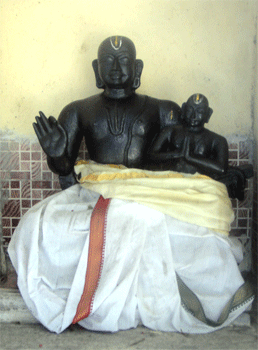 Varadaguru had the deepest Bhakti towards Varadaraja. One night when he was worshipping the deity in an ecstatic mood, the priest brought very hot milk to offer the Lord as Nivedana. Varadaguru was deeply upset that such hot milk would harm the tender tongue of the Lord! He stopped the priest from offering the hot milk and started cooling it down until it was just warm enough to be drunk. The Lord was moved by the tenderness and affection of a mother shown by Varada and called him ‘Amma’. From then onwards Varadaguru became Nadadoor Ammal.
Varadaguru had the deepest Bhakti towards Varadaraja. One night when he was worshipping the deity in an ecstatic mood, the priest brought very hot milk to offer the Lord as Nivedana. Varadaguru was deeply upset that such hot milk would harm the tender tongue of the Lord! He stopped the priest from offering the hot milk and started cooling it down until it was just warm enough to be drunk. The Lord was moved by the tenderness and affection of a mother shown by Varada and called him ‘Amma’. From then onwards Varadaguru became Nadadoor Ammal.
Ammal continued his Sri Bhashya Pravachana at the ripe old age of a hundred. Appullar, one of his disciples, had gone to visit his sister Totaramba at Thoopul. When he returned to Kanchi, his five-year-old nephew, Venkatanathan also accompanied him. As soon as he reached Kanchi, he went to see his beloved teacher and sought blessings. Ammal blessed the child and tried to pick up the discourse from where it stopped. He could not get the link, nor could anyone present guide him. To everyone’s surprise, little Venkatanathan prattled the Prakrit phrase and thus reminded the Acharya. Ammal’s joy knew no bounds and he understood that the child was an incarnation. He blessed the divine child with all his heart and soul that he would establish the Vedanta creed and be a terror to false arguments. Venkatanathan later proved Ammal’s prediction was right. He grows to be known as Sri Vedanta Desikan blessed by Sriranganathan and Sri Ranganayaki thayar of Sri Rangam.
The temple complex
It is a very simple temple facing east. Devotees can darshan of Sri Varadharajar, Perunthevi Thayar, and Andal from the main road itself since sannidhi for these deities are facing east. sannidhi for Sri Anjaneya is north facing and sannidhi for Nadadoor Ammal is south facing. One has to get into the temple complex to have the darshan of Sri Anjaneya and Nadadoor Ammal. Sri Nadadoor Ammal is seen with Sri Vedanta Desikan in his lap facing Sri Anjaneya sannidhi.
Sri Anjaneya
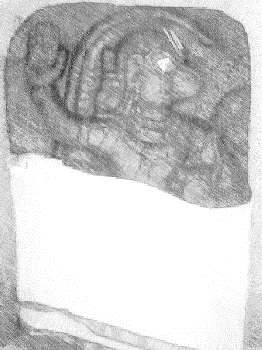 Sri Anjaneya moortham is embossed on granite stone and is about four and a half feet in height. Sri Anjaneya is facing north and is seen moving westward.
Sri Anjaneya moortham is embossed on granite stone and is about four and a half feet in height. Sri Anjaneya is facing north and is seen moving westward.
Lord is wearing nupur and thandai in His lotus feet. His strong calf muscle and sturdy thigh reflect His physical strength. Lord as a brahmachari is wearing loin cloth [kaupeenam]. Tail is seen raised and goes above His head and ends with a curve. He is holding the stem of the sowgandhika flower in His left hand which is resting on his left hip. The flower is seen above the left shoulder. The right hand of the Lord is seen raised and showing ‘abhaya mudra’, bestowing fearlessness to the devotees. Wrist He is wearing kangan and in the upper arm angad. On his broad chest, He is wearing a broad mala and another thin mala. Close to the neck, there is a necklace. The yagyopaveet is seen across his chest. He is wearing kundal in His ears which are touching the shoulders. His kesam is combed neatly, plaited, and held tightly by a decorative ‘kesa bhadha’. Puffy cheeks are glowing making His eyes more attractive. The brilliant eyes of the Lord glow with compassion thus bestowing benevolence to His devotees.
Location of the temple: "Sri Anjaneya Temple, Broadway, Chennai"
Experience
The temple and the Lord both look simple and at the same time admirable. darshan of the Lord who is full of humility is bound to bring out the importance of leading a simple life and will improve our self-control and pave the way for success in our lives.
SRI HANUMAN THINKS DIFFERENTLY, THINKS FAST
THINKS AHEAD AND ACTS FOR SURE
Ed [April 2021]
Updates: [Jan 2025]
